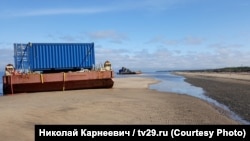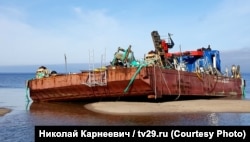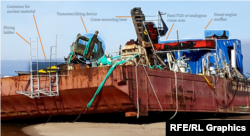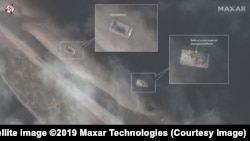The villagers were having none of it.
"What happened here? What was the fuel spilled?" one yelled.
"What's most important here is the government has said nothing, The local authorities have said nothing. Everyone is lying," another said.
At the meeting in the White Sea village of Nyonoksa, the focus of the anger was again the mysterious explosion last month at a Russian naval test range, an explosion that killed at least five people, sent a plume of radiation drifting over а nearby city, and sent analysts from Washington to Brussels to Oslo scrambling to figure out what was going on.
Nearly a month after the August 8 explosion, amid contradictory and sometimes misleading official statements, there's still no definitive explanation as to what occurred. But a growing body of evidence strongly suggests that a botched salvage operation may have led to the explosion.
The evidence now includes new detailed photographs that show some of the debris that resulted from the blast, including two platforms that were dragged ashore in the days after and which continued to emit moderate-to-high levels of radiation.
While Russian officials -- from President Vladimir Putin down to local authorities -- have sought to quell public fear, the August 31 meeting highlighted persistent anger among Russians about the fallout of the blast. First and foremost, that includes the villagers who have lived alongside the decades-old test site for years, accustomed to a major military presence.
The gathering was hosted by Andrei Klimov, an ecologist from Severodvinsk, a shipbuilding port located 35 kilometers from Nyonoksa, who has been outspoken in criticizing the official response to the incident.
In a video first published by news channel TV29 based in the nearby regional capital, Arkhangelsk, about three dozen people listened politely to Klimov as he explained he was seeking to calm fears about lingering health hazards.
About 450 people in all live in Nyonoksa, according to official records.
"The most important thing is that berries, mushrooms, produce from the dacha -- you can pick them" and eat them, Klimov told the group. He also, however, cautioned villagers not to eat fish caught nearby for the time being.
But the meeting quickly turned contentious. One man complained about comments made earlier-- four days after blast-- by a naval officer, who warned locals not to collect any flotsam washing up on shore, since it might be irradiated.
"Are you speaking to us as an official representative? Are you speaking officially?" the man asked Klimov at the August 31 meeting. "If a year from now we end up with some of sort environmental disease, are you prepared to pay everyone compensation?"
"What exactly exploded, tell us objectively?" the man continued. "What was the fuel spilled? What direction of the compass did it go?"
"That's a question for the Defense Ministry," Klimov responded.
The Defense Ministry has said little about the incident. A statement released the day the explosion occurred, two people had been killed, but gave no other details. Two days later, the state-run nuclear agency, Rosatom, revealed that five of its employees had been killed while they were conducting "technical-engineering oversight" of a test of "radioactive isotope fuel for a liquid-fueled rocket engine."
On August 26, Russia's federal weather agency said its sensors had detected several radioactive isotopes in Severodvinsk, including those that independent experts said were associated with a nuclear reaction, or a "fissile event."
Putin himself said the explosion occurred during a weapons test.
In the latest video, one unnamed man pointed specifically at two floating platforms that have been beached on the shoreline for nearly three weeks. "Let them take them away, or cut them up and drag them off through the village," he complained.
The floating platforms, or pontoons, meanwhile, provide more clues as to what happened, but leave more questions unanswered. The two platforms, which contained partially destroyed industrial equipment, have remained on the shore unguarded and without any explanation from authorities.
One was towed there on August 9, the day after the blast; the other arrived five days after, according to villagers.
One of the platforms has the remains of what appears to be a heavily damaged crane, along with a ladder for scuba divers or an underwater platform along with what appears to be a container for holding radioactive materials. That adds to evidence suggesting that there was an underwater, or near-surface, component to the work that was being conducted on August 8.
The presence of the pontoon platforms in the vicinity of the site immediately after the explosion also matches up with satellite imagery taken in the hours and days after the incident.
Geiger-counter readings taken by a reporter for TV29.ru, meanwhile, showed moderate to high levels of radiation emanating from a tow rope that was attached to one of the floating platforms. Another reading closer to the other platform also showed radiation levels in excess of normal background levels.
Bruno Chareyron, a research director at CRIIRAD, a French nongovernmental organization that monitors radiation, said the readings indicated that some of the beach debris showed clearly elevated radiation levels, though it was hard to know how hazardous the risk was without knowing the type of radiation being emitted.
Still, he said, it was possible that other items in the area -- for example, particles on the platforms -- could be more heavily irradiated. "This beach should be decontaminated," Chareyron told RFE/RL in e-mail. "The authorities should collect the radioactive debris, monitor the contamination of the water, sand sediments, fauna, and flora."
In the August 31 meeting, some of the villagers' ire was clearly directed at Klimov, who said he was asked to come speak to the community to allay fears, and who also said he blamed Rosatom for moving the weapons-testing equipment from the Barents Sea archipelago of Novaya Zemlya to Nyonoksa, thus endangering the local people.
"First and foremost, we need to come out against a repeat of any of these kinds of tests ever again," Klimov said. "They shouldn't be conducted here."
Klimov did not answer text messages and messages sent via social media seeking further comment.
Asked to comment on the criticism leveled by Nyonoksa residents, an unnamed Rosatom spokesperson told RFE/RL that "Rosatom is not in a position to comment on classified defense contracts and military tests.




